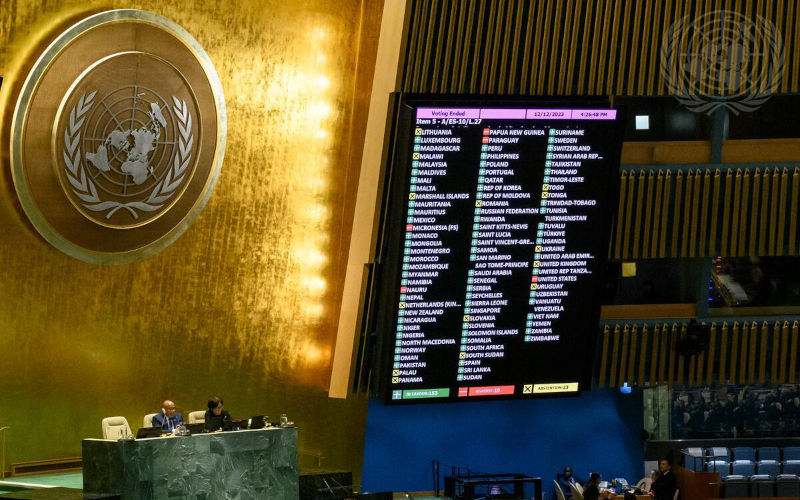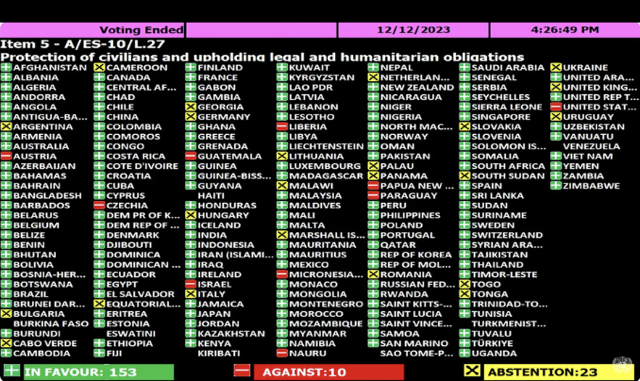It is urgent to end the loss of life and destruction in Gaza, but as the joint Statement by the Prime Ministers of Australia, Canada and New Zealand recognises, a sustainable ceasefire will require agreement to a balanced set of conditions consistent with eventually achieving a lasting peace based on a two-State solution. This is how to end the war in Gaza.
While Israel was clearly justified in defending itself against Hamas attack on 7 October, the enormous toll of death and destruction in Gaza is of mounting concern to the rest of the world. Around 18,000 Gazans have now been killed, most of them women and children, 90 per cent of the population has been displaced, and more than 70 per cent of the homes in Gaza have been destroyed.
At the end of last week, the UN proposed an immediate humanitarian cease fire. This UN resolution was supported by thirteen members of the Security Council, but was vetoed by the US, while the UK abstained.
This US veto has been widely condemned elsewhere, although as usual, there has been almost no criticism in the Australian media. OK a ceasefire might have allowed Hamas to regroup and continue fighting, but if the US vetoes a ceasefire, it is surely incumbent on it to spell out its alternative for ending the war and achieving a lasting peace as soon as possible.
By vetoing the ceasefire, the US is apparently supporting continuation of the war, and essentially on Israel’s terms. Bolstered by the US veto, and the purchase of an extra $US106 million worth of tank ammunition from the US since the veto was announced, Israel has been pushing ahead with its punishing air and ground offensive in Gaza, while the Gazan people are crowded into a smaller and smaller space with nowhere to hide.
While the US professes to want to end the war, unfortunately there is no sign that it will put forward an alternative proposal, until Israel has achieved its objective of annihilating Hamas. And while many may feel that the elimination of the “terrorist” group Hamas is a necessary condition for a lasting peace, there is a growing risk that Hamas elimination will only be accomplished by what should be a completely unacceptable loss of innocent lives and destruction of Gaza.
Thankfully in a joint statement released today (Wednesday 13 December), the Prime Ministers of Australia, Canada and New Zealand renewed the pressure for international action to achieve what they call a “sustainable ceasefire”.
As the three Prime Ministers recognise, a sustainable ceasefire “cannot be one-sided”. Hamas must release all hostages, lay down its arms, and there cannot be any role for Hamas in the future governance of Gaza.
The quid pro quo is that the three Prime Ministers:
- “Support Palestinians’ right to self-determination.”
- “Oppose the forcible displacement of Palestinians from Gaza, the re-occupation of Gaza, any reduction in territory, and any use of siege or blockade.”
- “Emphasise that Gaza must no longer be used as a platform for terrorism. We reaffirm that settlements are illegal under international law. Settlements and settler violence
are serious obstacles to a negotiated two-state solution.”
To this list of conditions, I would add that Israel equally must withdraw from Gaza after hostilities cease, and it cannot be the occupying power for any period. President Biden has previously indicated that he supports this condition, and it is difficult to see Hamas accepting laying down their arms, releasing all hostages, and going out of existence without Israel equally being required to withdraw. While on the other hand, all Israel’s legitimate demands for security will have been met.
Together these conditions are consistent with the widely accepted “two-State solution” guaranteeing the independence and security of both Israel and Palestine, which has been widely agreed as the basis for a lasting peace settlement.
But that still leaves the question of how to take this proposal forward. First, it will require a United Nations Security Council resolution, with US support this time. Second, there is an enormous task ahead to ensure security within Gaza and that Hamas does not reappear, to rebuild Gaza, and fill the gap in Palestinian political capability.
As I have argued in a previous article, “Gaza: Israel is winning the battle but losing the war”, that task is best undertaken by a UN trusteeship. Ideally, this trusteeship would be US-led, but personnel would also be drawn from other countries, and especially Arab countries such as Saudi Arabia.
By directly involving the US and the Arab countries, the trusteeship should have credibility with both Israelis and Palestinians. And involving the Arab countries directly in the administration of Gaza for an extended period would help induce them to open their purse strings to provide much of the necessary finance to rebuild Gaza.
Finally, the trusteeship would need to continue for some time – say three years – as it will take time to rebuild Gaza’s infrastructure and political capabilities when Hamas is gone.
For more on this topic, P&I recommends:
Michael Keating is a former Secretary of the Departments of Prime Minister and Cabinet, Finance and Employment, and Industrial Relations. He is presently a visiting fellow at the Australian National University.


